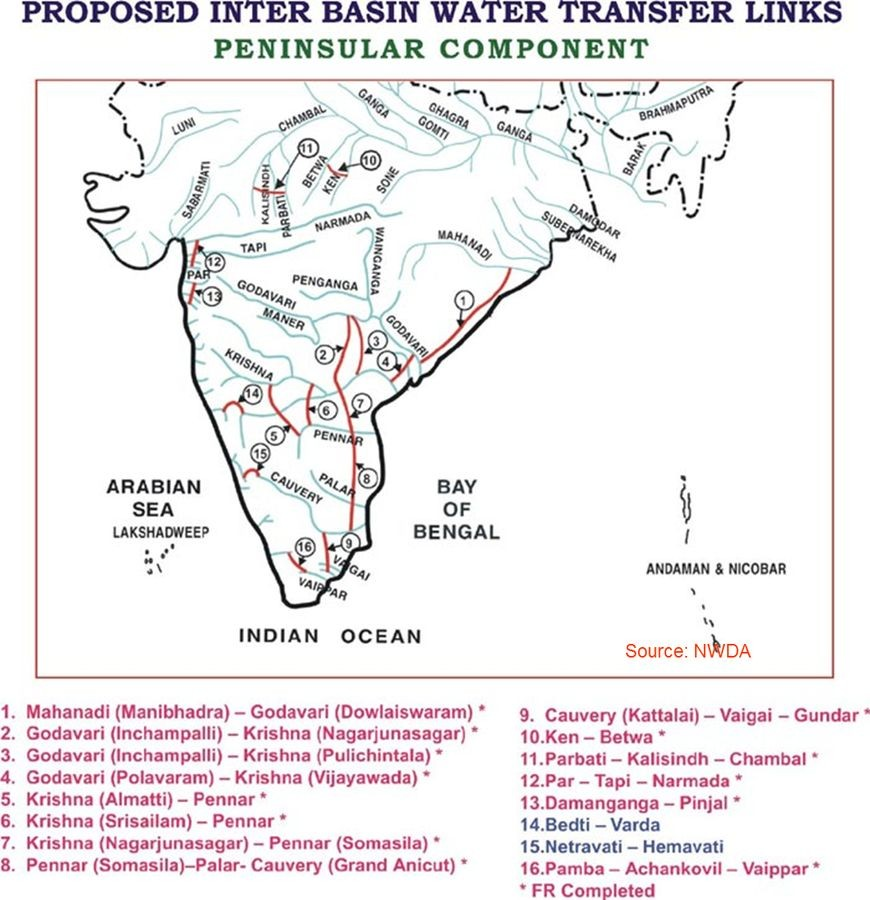- Filter By :
- Geography
- History
- Indian Heritage & Culture
- Indian Society
-
Q. "River interlinking projects have been hailed as a potential solution to water scarcity, yet their implementation raises concerns about ecological disruption and the long-term sustainability of such efforts. Comment." (250 Words)
28 Apr, 2025 GS Paper 1 GeographyApproach
- Briefly introduce the concept of the River Interlinking Project and its objectives.
- Explain the potential benefits of river interlinking, and also discuss its ecological concerns, and the long term sustainability of the project.
- Provide a balanced perspective, emphasizing the need for sustainable and well-planned projects.
Introduction
The Interlinking of River (ILR) Project, proposed by Sir Arthur Cotton in the 19th century and formalized in the National Perspective Plan (1980), aims to address water scarcity, by linking major rivers through a network of canals, and hydropower stations. While it could alleviate water stress and reduce flooding, concerns about its ecological impact, and long-term sustainability persist.
Body
ILR Project Offers Potential Solution:
- Water Security: The redistribution of water from surplus regions like the Ganga and Brahmaputra rivers to drought-prone areas, such as Bundelkhand, is a critical strategy to address state-specific water challenges.
- Initiatives like the Ken-Betwa project play a vital role in ensuring sustainable water access, focusing on local needs and long-term water security for regions facing severe droughts and water scarcity.
- Flood and Drought Mitigation: It can also mitigate the severe impacts of floods and droughts, preventing flooding in areas like Bihar and Assam, while alleviating water scarcity in regions like Marathwada and Vidarbha.
- Agricultural Boost: The project will increase irrigated agricultural land, significantly enhancing crop productivity and reducing dependency on uncertain monsoons. This could lead to food security for millions of farmers.
- The project’s ability to reduce water dependency on groundwater can lessen the pressure on depleting aquifers, promoting sustainable water usage in farming.
- Hydropower Generation: River interlinking will harness the hydropower potential of rivers, generating renewable energy through dams and reservoirs.
- India's total hydropower potential is estimated at 148,700 MW, with significant contributions expected from river projects, which will help meet the country’s growing energy demands.
- Transportation Benefits: Logistics costs in India, estimated at 14-18% of GDP (Economic Survey 2022-23), are significantly higher than the global average of 6-8%.
- Developing inland waterways, which are more cost-effective than road and rail transport, could reduce transportation costs, and ultimately decrease production costs.
Ecological and Sustainability Issues Regarding ILR Project:
- Disruption of Ecosystems: The diversion of river water could lead to the destruction of natural habitats for aquatic life and biodiversity.
- E.g. The Ken-Betwa project poses a threat to the Panna Tiger Reserve, highlighting the potential for damage to wildlife sanctuaries and national parks.
- Aquatic species, especially fish, depend on the natural flow of rivers for breeding and survival. The alteration of river courses could disrupt these ecosystems.
- Soil Salinity and Erosion: The flow of water could alter soil composition in areas that were not originally suited to receive excess water.
- This can result in soil erosion or increased salinity, particularly in coastal areas.
- Long-Term Sustainability: River interlinking projects depend heavily on consistent rainfall patterns.
- With changing climate conditions and unpredictable monsoons, such large-scale projects might not provide a long-term solution.
- Over-reliance on diverted river water can also result in depleted sources, exacerbating water shortages in surplus areas, and undermining the long-term sustainability of the project.
- Social and Economic Displacement: The creation of reservoirs and canals will lead to the displacement of thousands of people, particularly in rural areas, disrupting livelihoods and leading to social unrest.
- The project could escalate tensions between states over water sharing. Similar conflicts, such as the Cauvery dispute between Tamil Nadu and Karnataka, could become more widespread.
- High Financial and Operational Costs: The project requires a massive financial investment, with an estimated cost of ₹5.5 lakh crore, including the construction of dams, canals, and related infrastructure.
- The long-term maintenance and rehabilitation costs also present a significant financial burden.
Measures to Ensure Sustainability of ILR Project:
- Holistic Assessments: Use advanced tools (GIS, AI) for thorough environmental, social, and economic impact evaluations, to predict long-term outcomes and mitigate risks.
- Inclusive Participation: Promote participatory decision-making by actively involving states, local communities, and water experts to ensure that solutions are equitable, region-sensitive, and socially acceptable.
- Smart Water Management: Adopt IoT-based monitoring, sensor-driven irrigation, and real-time flood prediction tools.
- Scale up practices like drip and sprinkler irrigation, micro-watershed management, aquifer recharge, and rainwater harvesting to reduce dependence on large-scale diversions.
- Success models like Telangana’s Mission Kakatiya and Maharashtra’s Jalyukt Shivar can be adapted in other regions.
- Climate Resilience: Integrate adaptive strategies like drought-resistant crops and seasonal water budgeting.
Conclusion
The project must undergo comprehensive environmental and socio-economic impact assessments to ensure that it does not cause irreversible damage to India’s rivers, ecosystems, and communities. A more sustainable and equitable approach is essential for making the ILR a truly viable solution for India’s water woes.
To get PDF version, Please click on "Print PDF" button.
Print PDF






